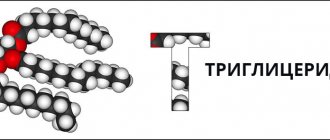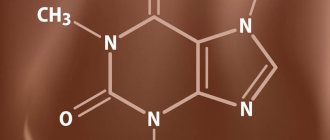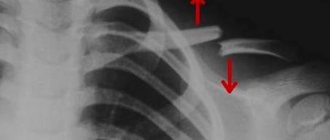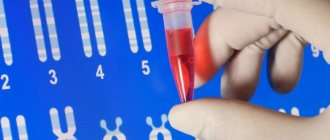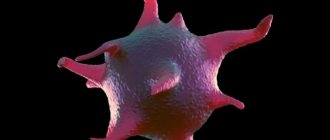What are triglycerides and why are they needed?
The substances are classified as simple fats and are present in large quantities in subcutaneous fat. They can enter the body in two ways:
- synthesis in the liver from carbohydrates and bile acids and subsequent transportation by low-density lipoproteins into the blood;
- nutritionally, i.e. together with food. This path is predominant and it is nutritional errors that often lead to the development of hypertriglyceridemia. Transport of triglycerides in this case is carried out by chylomicrons mainly into muscle fibers.
The main function is energy. However, with a large amount, the body is not able to absorb a huge amount of energy and begins to store it in the form of fat. Moreover, reserves are deposited not only under the skin, but also on internal organs, and metabolic processes are also disrupted. In such cases, the likelihood of developing diabetes mellitus, myocardial infarction, atherosclerosis, and stroke increases.
When is a blood test for triglycerides ordered?
The examination is indicated in the following situations:
- After 20 years (to exclude the development of atherosclerosis).
- High cholesterol content.
- Genetic predisposition.
- Hypertension.
- Diabetes.
- Increased body weight.
- Lipid metabolism disorders.
- Cardiac ischemia.
- During treatment (to monitor results).
- Angina pectoris.
After 20 years of age, examinations are recommended every five years; this makes it possible to prevent many diseases.
Causes of hypertriglyceridemia
The concentration of triglycerides in the blood changes in direct proportion to the patient's age. These changes are a variant of the norm if they proceed smoothly and fit into certain indicators. Hypertriglyceridemia can also develop for other reasons.
Hereditary factors are caused by genetic changes that are transmitted in an autosomal dominant manner from generation to generation. Currently, scientists have not been able to identify the exact gene and the mutations that occur in it. There is an assumption that hereditary hypertriglyceridemia has genetic heterogeneity, i.e., different genes change in each patient. However, most people have a disorder in the breakdown of triglycerides. As a result, the balance between their synthesis and catabolism shifts, which leads to an increase in their levels in the blood.
Hypertriglyceridemia can develop in pregnant women, when taking certain groups of medications, or in the presence of concomitant diseases, for example, liver pathology. As noted above, the most common cause of hypertriglyceridemia is dietary errors, namely increased consumption of fats and carbohydrates, since these nutrients are the building material for triglycerides.
Diagnostic methods
Diagnosis of hypertriglyceridemia is carried out mainly by laboratory methods. The following parameters are monitored in the blood serum:
- cholesterol;
- triglycerides;
- low and high density lipoproteins;
- specific liver enzymes, etc.
Additionally, instrumental diagnostic methods, for example, ultrasound of the abdominal organs, may be prescribed. If there is evidence of the hereditary nature of the disease, the doctor prescribes genetic tests, which can be taken at a medical genetics clinic.
Medicines designed to lower triglyceride levels
- Fibrates. Belong to carboxylic acids. The decrease in the indicator occurs due to the amphipathic function;
- A nicotinic acid. Acts in the same way as fibrates, but increases the level of “good” cholesterol;
- Omega-3 fatty acids. With their help, a decrease in triglycerides is achieved quickly. A cheap and accessible product that can be found in every pharmacy is fish oil;
- Statins. Fights “bad” cholesterol.
Fish oil is a widely available source of omega-3 fatty acids that help maintain proper triglyceride balance.
The listed drugs must be used with caution. It is worth remembering that taking these medications can cause various side effects:
- stomach upsets;
- dizziness;
- a sharp decrease in blood pressure;
- breathing problems;
- rash.
Treatment of hypertriglyceridemia
The specific treatment plan largely depends on the patient’s condition and the reasons that led to the development of hypertriglyceridemia. If a person leads a sedentary lifestyle, is overweight, or does not eat properly, then he is prescribed a diet that involves reducing fat in the diet, a physical activity plan is drawn up, and they are helped to adjust the weight.
Drug treatment for hypertriglyceridemia involves prescribing drugs that lower blood lipid levels. These include statins, fibrates, vitamin B5. Monotherapy is usually used in minimal dosages. However, if the treatment does not bring the desired effect, the doctor may prescribe a complex of several drugs. After the triglyceride level returns to normal values, the patient receives a list of recommendations regarding his lifestyle and dietary habits. If you ignore your doctor's advice, hypertriglyceridemia may develop again.
Norms
When conducting biochemical blood tests for TG levels, it is necessary to take into account the gender and age of the person, since the standards are different and depend on these indicators.
In females
In women, triglyceride levels increase with age, so they should be slightly lower than in men:
- From 15 to 20 years - 0.41-1.54 mmol / l.
- From 21 to 40 years old - from 0.43 to 1.64.
- From 41 to 50 - 0.45-2.15.
- From 50 to 60 years old - from 0.52 to 2.64.
- After 60 years - up to 2.7 mmol/l.
During pregnancy, triglyceride levels fluctuate constantly due to hormones and spontaneously recover after childbirth.
In males
Men's triglyceride levels are higher than women's, and they also change with age:
- From 15 to 20 years - from 0.44 to 1.80 mmol / l.
- From 21 to 55 years old - 0.53-3.6.
- From 56 years old - 0.64-2.9.
If the TG content is 10 or more times higher than normal, it is assumed that this is a hereditary disease - primary triglyceridemia.
In children
For children, the norms are as follows:
- From birth to 1 year - 0.2-0.94 mmol / l.
- Further, for girls under 15 years old - from 0.4 to 1.48.
- For boys - from 0.35 to 1.41.
Sample meal plan
Below is a sample meal plan that may help lower your triglyceride levels.
| Option 1 | Option 2 | Option 3 | |
| Breakfast | salmon, poached egg and watercress, whole grain rye bread | buckwheat pancake with blueberries and low-fat yogurt | porridge with low-fat or vegetable milk, sprinkled with pumpkin seeds and berries |
| Dinner | Avocado, spinach, tomato and hummus salad | lentil and vegetable soup with oatcakes | sardines on whole grain toast with a side of salad greens |
| Dinner | stir-fry chicken and vegetables with brown rice | butternut squash and tofu curry, served with cauliflower rice | vegetable and bean chili, served with stewed cabbage |
| Snack | banana, almonds | boiled egg and whole grain pita slices | celery sticks and nut butter |
Calculation of the atherogenic index
The atherogenic coefficient is an indicator that reflects the degree of risk of developing heart and vascular disease.
In the development of atherosclerotic plaques in blood vessels, not only an increase in the total amount of cholesterol in the blood is important, but also the ratio between “bad” and “good” cholesterol. This is what the atherogenicity coefficient reflects. It is calculated using the following formula: KA = (total cholesterol - HDL)/HDL .
The optimal atherogenicity coefficient is 2-3.
Apolipoproteins
- Apolipoprotein A1 is a protein that plays a specific role in lipid metabolism and is also the main protein component of HDL. Activates enzymes that unload cholesterol from tissues into HDL particles and allow them to be recognized by liver receptors and bind to these receptors. Apolipoprotein A1 concentration can be measured directly and tends to fall and rise with HDL levels.
- Apolipoprotein B is the main protein in all lipoproteins, with the exception of HDL. Reflects the danger of developing atherosclerotic lesions, thus being its marker. In addition, apolipoprotein B plays a major role in the recognition and binding of LDL by special receptors located on the membranes of almost all cells of the body, in addition to red blood cells and cells of the nervous system.
Choose the right fats
The body needs fats to function properly, but some fats are healthier than others. Choosing healthy fats can lower triglyceride levels. Solid fats come from meats, full-fat dairy products, and some tropical oils such as coconut and palm. These foods contain trans fats and saturated fats. Trans fats and saturated fats increase triglyceride levels and should be replaced wherever possible.
Unsaturated fats, especially polyunsaturated fats (PUFAs), lower triglyceride levels. Avocados and olive oil contain monounsaturated fats. Omega-3 fats are found in fish oil, flaxseed and cold-water fish such as salmon and sardines. You can add PUFAs to your diet by consuming these foods. Instead of a steak or hamburger, which is high in saturated fat, you can opt for a salmon fillet or a tuna sandwich. Animal products such as lean meats, fresh poultry, low-fat or low-fat dairy products and seafood are also good options. Fats should make up 25 to 35 percent of the diet.
Choose your drinks carefully
Drink water instead of sweetened drinks. Even bottled juices can be high in sugar. Beverages often contribute significantly to total carbohydrate and sugar intake. Fruit drinks, soft drinks, and other sugar-sweetened beverages are among the major sources of added sugars in the diet.
Alcohol also has a direct effect on triglyceride levels in some people. People seeking to lower triglyceride levels should avoid drinking alcohol. Avoiding drinks containing added sugar can significantly reduce your overall calorie intake. Instead of high-sugar drinks, people can choose low-calorie drinks such as water or tea. On a hot day, instead of reaching for a cold drink, try adding some fruit juice to a glass of sparkling water.
Reduce your sugar intake
Sugar is a form of carbohydrate and is high in calories. Foods high in simple sugars, especially refined fructose, can raise triglyceride levels. Added sugar comes in many forms, including:
- white sugar
- Brown sugar
- honey
- cane juice or cane syrup
- corn sweetener or corn syrup
- fruit juice concentrate
- glucose
- fructose
- dextrose
- maltose
- lactose
- sucrose
- syrups such as maple, agave and molasses
Added sugar should be avoided to reduce triglyceride levels.
Instead of sugar, sprinkle spices such as cinnamon or ginger onto your cereal or oatmeal to add flavor. Choose fruit desserts instead of ice cream or sticky puddings. When purchasing ready-to-eat foods, remember that many of them, including some savory foods such as tomato ketchup, contain added sugar.
Every 4 grams of sugar is equivalent to 1 teaspoon. Cardiologists recommend a daily maximum sugar intake of 25 g (about 6 teaspoons) for women and 36 g (9 teaspoons) for men.
Features of laboratory analysis
To obtain objective data, several conditions must be met when performing a lipid profile. The preparatory stage contains the following recommendations:
- 24 hours before the test, drinking alcohol is prohibited;
- the analysis is carried out on an empty stomach;
- at least 24 hours of dietary nutrition, low in fat.
Failure to comply with these requirements may result in distorted results. If there is a hereditary tendency to increase cholesterol, it is recommended to carry out the analysis up to 2 times a year.
